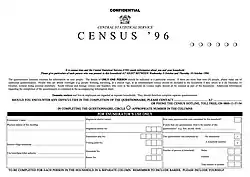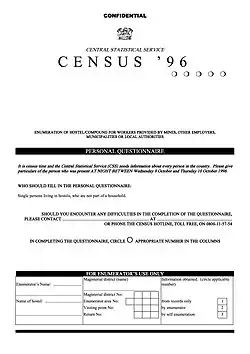1996 South African census
The National Census of 1996 was the 1st comprehensive national census of the Republic of South Africa, after the end of Apartheid. It undertook to enumerate every person present in South Africa on the census night at a cost of R 419,000,000.[1]
| 1996 National Census | ||
|---|---|---|
| ||
 | ||
| General information | ||
| Country | Republic of South Africa | |
| Results | ||
| Total population | 40,583,573 ( | |
| Most populous | KwaZulu-Natal | |
| Least populous | Northern Cape | |
Pre-enumeration

Personal questionnaire

Institution questionnaire
Results
Demographics
| Rank | Race | 1991 Census | 1996 Census | Difference | Percent difference |
|---|---|---|---|---|---|
| 1 | Black African | 21,646,000 | 31,127,631 | ||
| 2 | White | 5,068,000 | 4,434,697 | ||
| 3 | Coloured | 3,286,000 | 3,600,446 | ||
| 4 | Asian or Indian | 987,000 | 1,045,596 | ||
| Total population | 30,987,000 | 40,583,573 | |||
| First language | Eastern Cape | Free State | Gauteng | KwaZulu-Natal | Mpumalanga | Northern Cape | Northern Province | North West | Western Cape | South Africa |
|---|---|---|---|---|---|---|---|---|---|---|
| Black African | 86.4 | 84.4 | 70 | 81.7 | 89.2 | 33.2 | 96.7 | 91.2 | 20.9 | 76.7 |
| Coloured | 7.4 | 3 | 3.8 | 1.4 | 0.7 | 51.8 | 0.2 | 1.4 | 54.2 | 8.9 |
| Asian or Indian | 0.3 | 0.1 | 2.2 | 9.4 | 0.5 | 0.3 | 0.1 | 0.3 | 1 | 2.6 |
| White | 5.2 | 12 | 23.2 | 6.6 | 9 | 13.3 | 2.4 | 6.6 | 20.8 | 10.9 |
| Unspecified/Other | 0.6 | 0.4 | 0.8 | 0.8 | 0.6 | 1.5 | 0.7 | 0.5 | 3.1 | 0.9 |
| Total | 100 | 100 | 100 | 100 | 100 | 100 | 100 | 100 | 100 | 100 |
| Rank | First language | 1991 Census | 1996 Census | Difference | Percent Difference |
|---|---|---|---|---|---|
| 1 | IsiZulu | 9,200,144 | % | ||
| 2 | IsiXhosa | 7,196,118 | % | ||
| 3 | Afrikaans | 5,811,547 | % | ||
| 4 | Sepedi | 3,695,846 | % | ||
| 5 | Setswana | 3,301,774 | % | ||
| 6 | English | 3,457,467 | % | ||
| 7 | Sesotho | 3,104,197 | % | ||
| 8 | Xitsonga | 1,756,105 | % | ||
| 9 | SiSwati | 1,013,193 | % | ||
| 10 | Tshivenda | 876,409 | % | ||
| 11 | IsiNdebele | 586,961 | % | ||
| 12 | Other | 228,275 | % |
| Rank | Gender | 1991 Census | 1996 Census | Difference | Percent difference |
|---|---|---|---|---|---|
| 1 | Female | 15,507,000 | 21,062,685 | ||
| 2 | Male | 15,480,000 | 19,520,887 |
| Rank | Province | 1991 Census | 1996 Census | Difference | Percent difference |
|---|---|---|---|---|---|
| 1 | KwaZulu-Natal | 8,417,021 | % | ||
| 2 | Gauteng | 7,348,423 | % | ||
| 3 | Eastern Cape | 6,302,525 | % | ||
| 4 | Limpopo | 4,929,368 | % | ||
| 5 | Western Cape | 3,956,875 | % | ||
| 6 | North West | 3,354,825 | % | ||
| 7 | Mpumalanga | 2,800,711 | % | ||
| 8 | Free State | 2,633,504 | % | ||
| 9 | Northern Cape | 840,321 | % | ||
| Total population | 40,583,573 | % | |||
| First language | Eastern Cape | Free State | Gauteng | KwaZulu-Natal | Mpumalanga | Northern Cape | Northern Province | North West | Western Cape | South Africa |
|---|---|---|---|---|---|---|---|---|---|---|
| Afrikaans | 9.6 | 14.5 | 16.7 | 1.6 | 8.3 | 69.3 | 2.2 | 7.5 | 59.2 | 14.4 |
| English | 3.7 | 1.3 | 13.0 | 15.8 | 2.0 | 2.4 | 0.4 | 1.0 | 20.3 | 8.6 |
| IsiNdebele | 0 | 0.2 | 1.6 | 0 | 12.5 | 0 | 1.5 | 1.3 | 0.1 | 1.5 |
| IsiXhosa | 83.8 | 9.4 | 7.5 | 1.6 | 1.3 | 6.3 | 0.2 | 54.4 | 19.1 | 17.9 |
| IsiZulu | 0.4 | 4.8 | 21.5 | 79.8 | 25.4 | 0.3 | 0.7 | 2.5 | 0.1 | 22.9 |
| Sepedi | 0 | 0.2 | 9.5 | 0 | 10.5 | 0 | 52.7 | 4.0 | 0 | 9.2 |
| Sesotho | 2.2 | 62.1 | 13.1 | 0.5 | 3.2 | 0.9 | 1.1 | 5.1 | 0.4 | 7.7 |
| SiSwati | 0 | 0.1 | 1.3 | 0.1 | 30.0 | 0 | 1.2 | 0.5 | 0 | 2.5 |
| Setswana | 0 | 6.5 | 7.9 | 0 | 2.7 | 19.9 | 1.4 | 67.2 | 0.1 | 8.2 |
| Tshivenda | 0 | 0.1 | 1.4 | 0 | 0.1 | 0 | 15.5 | 0.4 | 0 | 2.2 |
| Xitsonga | 0 | 0.5 | 5.3 | 0 | 3.5 | 0 | 22.6 | 4.7 | 0 | 4.4 |
| Other | 0.2 | 0.3 | 1.3 | 0.5 | 0.4 | 0.8 | 0.3 | 0.5 | 0.6 | 0.6 |
| Total | 100 | 100 | 100 | 100 | 100 | 100 | 100 | 100 | 100 | 100 |
Employment
| First language | Eastern Cape | Free State | Gauteng | KwaZulu-Natal | Mpumalanga | Northern Cape | Northern Province | North West | Western Cape | South Africa |
|---|---|---|---|---|---|---|---|---|---|---|
| Employed | 786 818 | 701 175 | 2 564 243 | 1 570 573 | 605 925 | 215 523 | 570 129 | 725 287 | 1 374 174 | 9 113 847 |
| Unemployed | 742 427 | 299 948 | 1 007 766 | 1 008 944 | 297 290 | 86 060 | 486 554 | 443 546 | 299 114 | 4 671 647 |
| Total | 1 529 244 | 1 001 122 | 3 572 009 | 2 579 517 | 903 215 | 301 583 | 1 056 683 | 1 168 833 | 1 673 288 | 13 785 493 |
| Unemployed as percentage of total | 48% | 29% | 28% | 39% | 32% | 28% | 46% | 37% | 17% | 33% |
Labour market status of the population aged 15 - 65 years by population group – October 1996[3]
References
- Using the 2001 Census: Approaches to analysing data (PDF). Statistics South Africa and the Human Sciences Research Council. 2007. ISBN 978-0-621-37259-5. Retrieved 24 November 2015.
- Primary tables South Africa: Census '96 and 2001 compared (PDF). Statistics South Africa. 2004. pp. 4–5. ISBN 0-621-34320-X. Retrieved 24 November 2015.
- "The People of South Africa Population Census 1996 - Census in Brief" (PDF). Stats SA. p. 9. Retrieved 28 March 2022.
- Primary tables South Africa: Census '96 and 2001 compared (PDF). Statistics South Africa. 2004. pp. 9–12. ISBN 0-621-34320-X. Retrieved 24 November 2015.
- Primary tables South Africa: Census '96 and 2001 compared (PDF). Statistics South Africa. 2004. pp. 20–23. ISBN 0-621-34320-X. Retrieved 24 November 2015.
- Primary tables South Africa: Census '96 and 2001 compared (PDF). Statistics South Africa. 2004. pp. 4–5. ISBN 0-621-34320-X. Retrieved 24 November 2015.
This article is issued from Wikipedia. The text is licensed under Creative Commons - Attribution - Sharealike. Additional terms may apply for the media files.